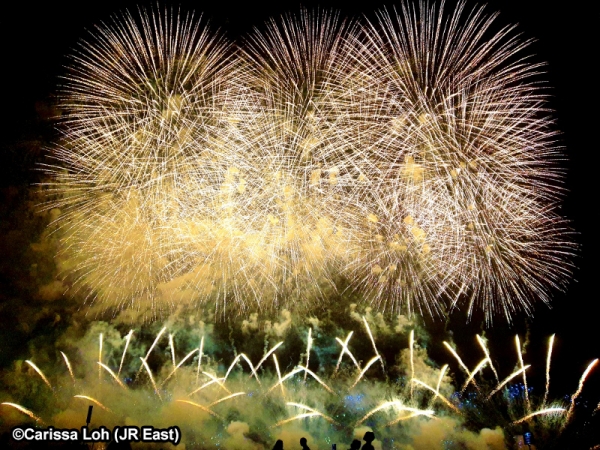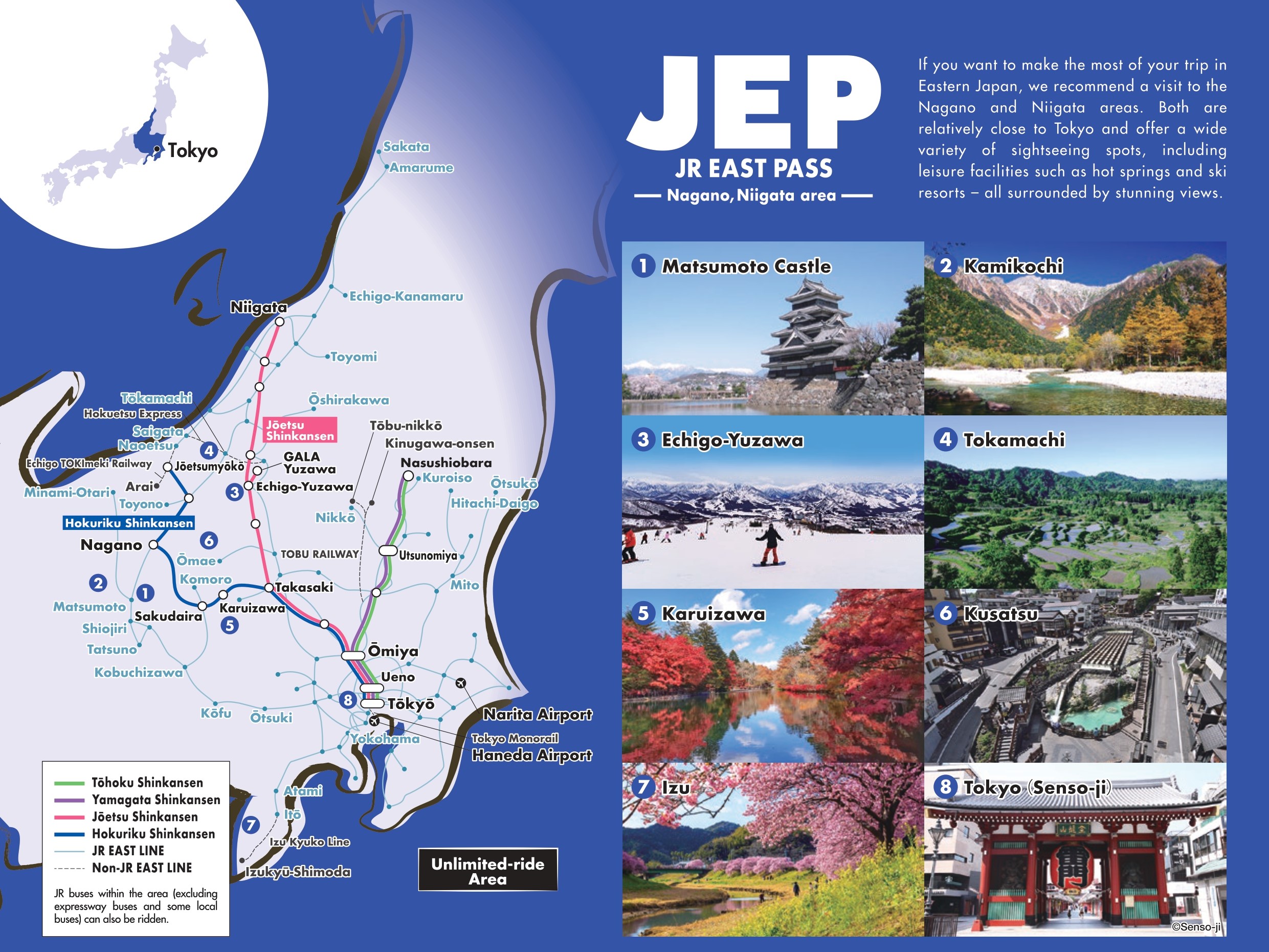Japan’s most beautiful fireworks festival: Nagaoka Fireworks Festival

Ask any Japanese person what they think represents summer, and chances are their answer is hanabi (花火 fireworks). Hundreds of spectacular fireworks festivals and shows are held all over Japan during summer weekends. In addition to the stunning displays that light up the evening sky, most festivals have a wonderful atmosphere with street food and game stalls, making for a fun and enjoyable evening. Put on a yukata to further enjoy the festivities!

Omagari Fireworks Festival in Akita. (Image credit: Akita Prefecture)
Did you know? All of the 「Three Great Fireworks Festivals of Japan」are in held in Eastern Japan. They are the Omagari Fireworks Festival, the Nagaoka Fireworks Festival and the Tsuchiura All Japan Fireworks Competition.

My favourite segment of the Nagaoka Fireworks Festival. (Image credit: JR East / Carissa Loh)
I can’t believe it took me so long, but I finally had my first hanabi taikai (花火大会 fireworks festival) experience in 2019, visiting the Nagaoka Fireworks Festival (長岡まつり大花火大会 Nagaoka matsuri hanabi taikai). Sure enough, it did not disappoint, and left me wanting to come back again.

Exterior of the GENBI SHINKANSEN decorated with images of the Nagaoka Fireworks Festival. (Image credit: JR East / Carissa Loh)
I had heard of the Nagaoka Fireworks Festival for a long time, but it never made my list of places to visit, because summer in Japan is known for being atrociously hot and humid. It wasn’t until I rode the GENBI SHINKANSEN in 2018 that I found out about the history and significance of the festival in greater detail, and was moved to visit it in 2019. (Note: The GENBI SHINKANSEN ceased operations in December 2020)
Hope and recovery: the origins of the Nagaoka Fireworks Festival

Vesuvius Super Grand Starmine fireworks (Image credit: JR East / Carissa Loh)
Held over two nights, the Nagaoka Fireworks Festival is the highlight of the three day Nagaoka Festival (1–3 August annually). Be enthralled by the large-scale, awe-inspiring bursts of colours lighting up the night sky over the Shinano River. As one of the 「Three Great Fireworks Festivals of Japan」, you can expect many stunning pyrotechnic displays during this show.

“Furusato wa hitotsu” fireworks segment. (Image credit: JR East / Carissa Loh)
Although Japan holds countless big and small fireworks festivals over the summer weekends, few carry as much history and emotion as the Nagaoka Fireworks Festival. Not just another festival, this annual spectacular was started as a war-damage recovery event in 1946, as a memorial for the 01 August 1945 bombing of Nagaoka during World War II, which killed 1,500 people and destroyed 65–80% of the city. Other than commemorating the dead, the festival also gives thanks for the city’s rebuilding, and prays for everlasting peace.
Highlights of the Nagaoka Fireworks Festival
Nagaoka Fireworks Festival’s Phoenix Fireworks segment. (Video credit: Nagaoka Fireworks Foundation)
The highlight of the show is without a doubt the “Phoenix Fireworks: Wishing for Recovery” segment. This 5-minute segment is perfectly synchronised to the tune of Hirahara Ayaka's song "Jupiter", which was written to wish for the recovery and reconstruction of Chūetsu (中越), a region in Niigata affected by a large earthquake in 2004.

Phoenix Fireworks segment. (Image credits: JR East / Carissa Loh)
To many people, the Nagaoka Fireworks Festival embodies gratitude, and hope for the future. The melody of the song, coupled with the majestic fireworks display, moves many attendees to tears, and evokes feelings of appreciation and hope.

Ticket (left) and mat seats at the Nagaoka Fireworks Festival (right). (Image credit: JR East / Carissa Loh)
Like most fireworks shows in Japan, both ticketed seats (paid seating) and free seats (bring your own mats to sit along the riverside / roadside etc.,) are available, so you can choose how you would like to enjoy the fireworks. I am not a fan of crowds, so I preferred to get a ticketed seat with a set space, rather than to be squeezed on all sides. Toilets and food stalls are also available within the tickets grounds. Being a well-loved festival, tickets to the Nagaoka Fireworks Festival sell out months in advance, so I was very lucky to be able to get a ticket by joining a day tour.

Sunset (left) and one of the shiragiku fireworks in the opening segment (right). (Image credit: JR East / Carissa Loh)
Each year, the opening segment features three shiragiku (白菊 white chrysanthemum) fireworks, launched as an offering to those who died from the 1945 bombing. As it is summer, sunset is quite late. Despite it already being 19:20, the skies still had a faint red glow from the setting sun, which provided a warm background for the first few sets of fireworks.

Shō-sanjakudama fireworks over the Chōsei Bridge. (Image credit: JR East / Carissa Loh)
Other than the highly anticipated Phoenix Fireworks, among the other highlights is the huge shōsanjakudama (正三尺玉 3-foot-diameter shell fireworks) over the Chōsei Bridge. Looking up, it is amazing to see how large it is in comparison to the bridge. The fireworks go up to 650m wide!

Finale of the festival. (Image credit: JR East / Carissa Loh)
The touching finale, dubbed the Kome Hyappyō (米百俵), is where 100 fireworks are shot off in succession for a continuous display. Rice (米 kome) is Niigata’s most famous product, and kome hyappyō literally means “a hundred bags of rice”. It refers to an event in history in which donated bags of rice were sold to provide education instead of being distributed for consumption, and is now used as an anecdote for persevering in the present for the sake of a better future. The fireworks are meant to convey this ideal to the audience, and are set off to the beautiful melody of the song “Look upon the Sky” (空を見上げてごらん sora wo miagete goran).

Finale of the festival. (Image credit: JR East / Carissa Loh)

Orderly movement towards the train station. (Image credit: JR East / Carissa Loh)
After the spectacular finale, I thought that going back to the train station after the festival would be a nightmare, as over 500,000 people come to see the fireworks per night. However, it was surprisingly very organised. Friendly JR staff hold signs letting people know which queue to go to for the bullet trains, and which queue for the local lines. Extra train services operate during the festival period to accommodate the huge crowd. Everyone was orderly, and there was no pushing or shoving.
As a small town, accommodation in Nagaoka during this period is almost impossible to get, but Niigata (a 20-minute bullet train ride away) was available during my trip.

Vesuvius Super Grand Starmine fireworks (Image credit: JR East / Carissa Loh)
To me, there are no words to fully describe how amazing the Nagaoka Fireworks Festival was. The fireworks are massive, and appear very close to you – left, right, front, above. The viewing area is also very spacious and well-arranged, so you don't feel cramped or blocked despite the large number of people. Far from being just a fireworks-viewing experience, the thought and meaning put into the fireworks really made the Nagaoka Fireworks Festival a fantastic night to remember.
I thoroughly enjoyed my first fireworks festival experience at Nagaoka, and highly recommend it to anyone wishing to experience a Japanese fireworks festival. The Nagaoka Fireworks Festival really set high expectations for any future fireworks festivals I attend, and hopefully I can come back again someday.
Event details
Date: 02 and 03 August annually
Time: 19:20~21:15
Website: English | Japanese
Venue: Banks of the Shinano River in Nagaoka
Getting there
The Nagaoka Fireworks Festival venue is a 30-minute walk from JR Nagaoka Station (長岡駅). On the festival days, the route is well-marked with signs, directing you to the respective seating zones. JR Nagaoka Station is a 105-minute bullet train ride from JR Tōkyō Station (東京駅) on the Jōetsu Shinkansen Line, or 20 minutes from JR Niigata Station (新潟駅) on the Jōetsu Shinkansen Line.
JR EAST PASS (Nagano, Niigata area)

The new JR EAST PASS (Nagano, Niigata Area) and usage area. (Image credit: JR East)
If you are thinking of visiting the Nagaoka Fireworks Festival or visiting the rest of Niigata Prefecture, check out the JR EAST PASS (Nagano, Niigata area), an affordable pass offering unlimited rail travel on JR East lines (including bullet trains) in the area for 5 consecutive days. At only ¥27,000, it makes for a great companion for rail travel around Nagano and Niigata. You can also make seat reservations for bullet trains, some limited express trains and Joyful Trains online for free, up to 1 month in advance, on the JR-EAST Train Reservation.

The JR-EAST Train Reservation. (Image credit: JR East)
Header image credit: JR East / Carissa Loh




